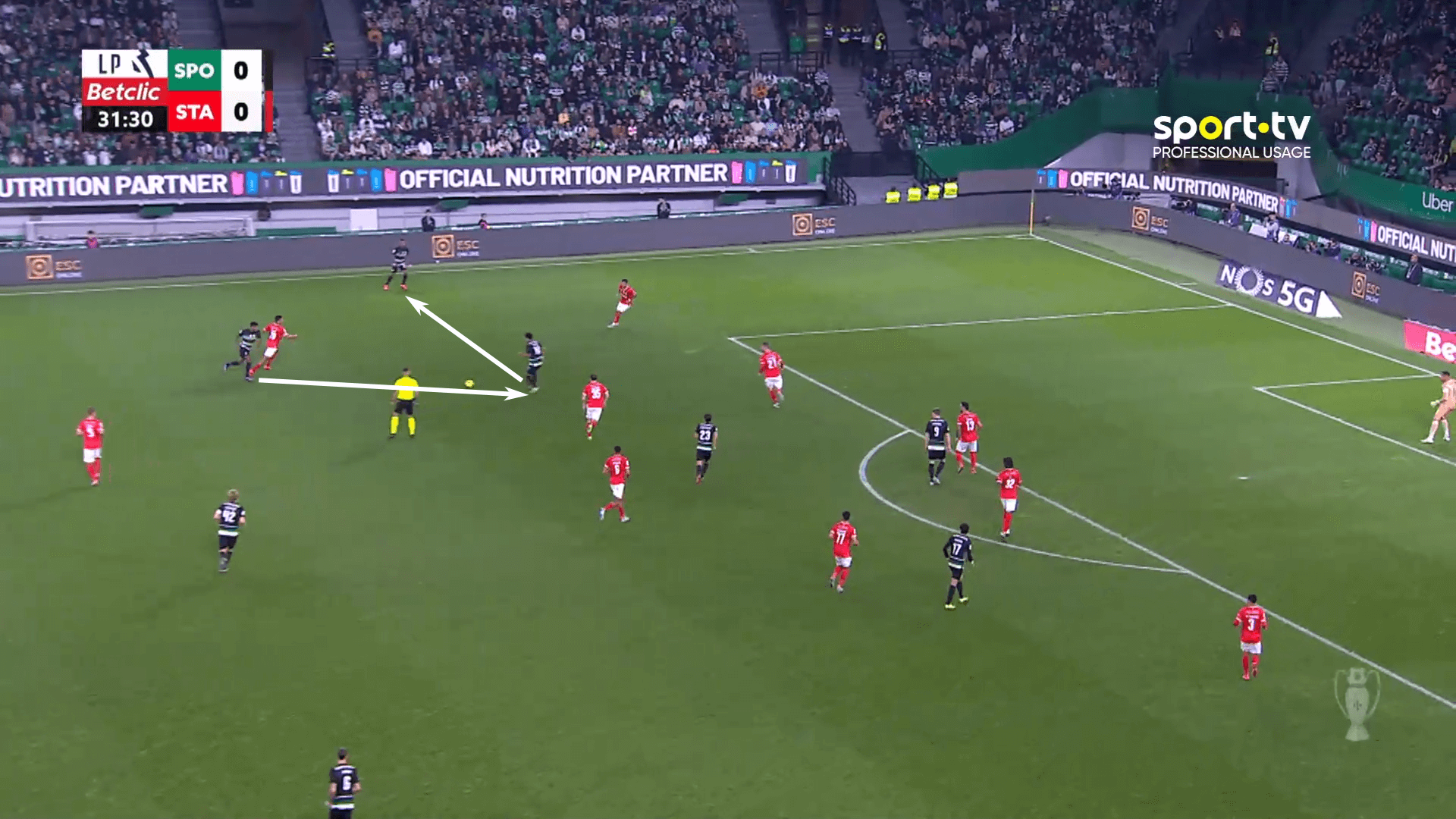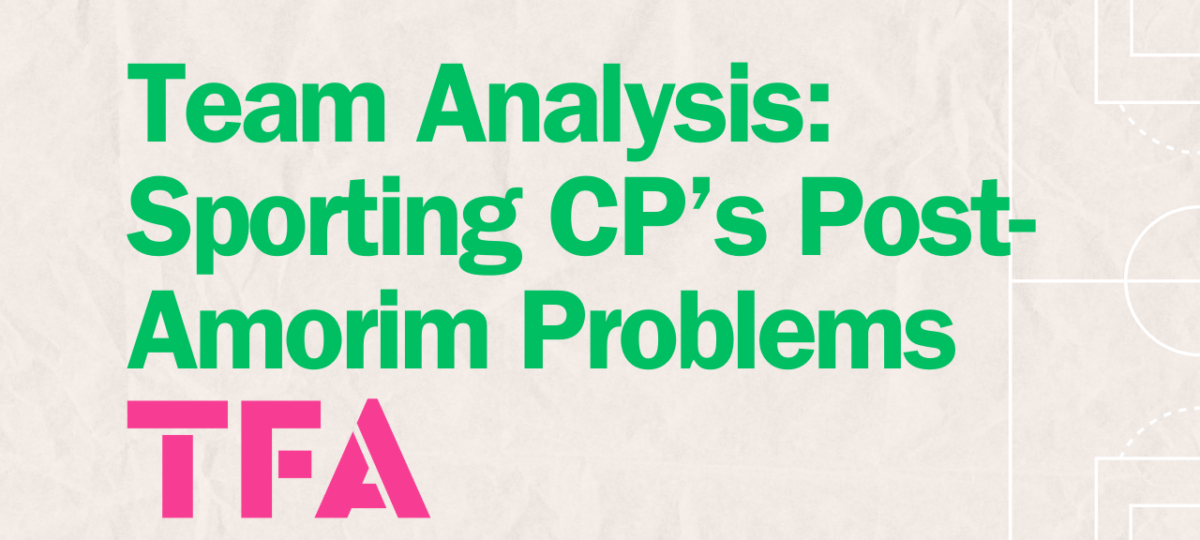Just weeks ago, you could argue that Sporting CP were one of the game's most in-form teams.
With a 4-1 thrashing of Manchester City in the Champions League and a resolute 4-2 comeback victory over Braga in the Primeira Liga, Ruben Amorim’s Sporting side had all the momentum you could ask for.
But then Amorim left for Manchester United.
While the Portuguese manager has begun the acclimation phase to the Premier League, Sporting have found themselves in a small crisis.
Their Primeira Liga lead was slashed, and they fell from second to 17th in the Champions League.
After an initial victory in the Taça de Portugal, new manager and former Sporting player João Pereira endured a tumultuous first few weeks on the job.
A victory yesterday over Boavista has brought some relief to the Portuguese capital, but results must continue to flow.
This tactical analysis will look at the data to distinguish between the two managers and then some of the underlying tactics leading to the loss in form.
The primary focus of this scout report is to look at the issues Sporting’s prolific attack has encountered in recent weeks and one area that can help reverse their offensive woes.
Sporting CP's Data Under Rúben Amorim & Joao Pereira
Sporting’s CP data is fascinating.
A team that looked like world-beaters prior to the international break, Sporting was on a run of four consecutive losses across the Primeira Liga and Champions League before Saturday’s win.
Extracting the data from those two competitions, we can see just how stark a difference there is in Sporting’s form during that four-match downturn.
Under Rúben Amorim's tactics, we had a side averaging 2.38 xG P90 and even outperforming that lofty figure with approximately 2.68 goals P90.
It seemed as though everything was falling Sporting's way.
Sporting Goals And xG - Rúben Amorim Vs Joao Pereira

Once Amorim left for Manchester United, the results and production fell off a cliff.
Under Joao Pereira's style of play, xG dropped to 1.4, but the bigger issue was how far below that mark Sporting’s goal production fell.
They simply looked like a different team, averaging 0.75 goals per game.
We see a similar trend when looking at xG against.
Sporting conceded approximately 1.0 xG to their opponents each game but gave up 0.89 goals P90.
The caveat is that Arsenal were absolutely clinical against Sporting in Champions League play, but we still see that this Sporting side gave up 1.4 xGA in those four European and League games while conceding 2.5.
Sporting Goals Against and xG Against - Rúben Amorim Vs Joao Pereira

The final third success, both for and against, has been a massive issue for Sporting.
They've actually had more success generating shots from positional attacks under Pereira, but they were also averaging far fewer touches in the box P90.
Sporting's Final Third Success - Rúben Amorim Vs Joao Pereira

Shot quality and chance creation have been issues.
Meanwhile, Sporting have seen a 38% increase in opponent touches in the penalty area P90 while giving opponents fewer final third entries.
Final Third Success For Sporting's Opponents - Rúben Amorim Vs Joao Pereira

It's an interesting conundrum for Pereira.
On the one hand, keeping the opponent out of the final third is successful, but the greater issue is the opposition’s ability to enter the box.
Sporting opponents are creating more and better chances despite fewer opportunities to access their final third.
Sporting’s Passing Network & Progression Trends Under Amorim & Joao Pereira
Could Sporting’s woes in the final third, or at the very least the attacking half, be at the heart of their attacking and defensive issues?
We understand the implications of their success in creating goal-scoring opportunities, their ability to hold their shape, and the location of their losses.
The two are intertwined.
To evaluate Sporting’s attacking issues, we pulled up a pass map to get a sense of their patterns in possession.
We do see both teams use the back three and two pivots significantly in the middle third.
Play is generally central as Sporting move into the attacking half of the pitch.
Sporting CP Pass Map Under Joao Pereira Vs Rúben Amorim

Once we get to the final third, the picture changes.
One difference is that Pereira’s Sporting connect more passes in Zone 14 than Amorim’s side.
The second insight is that when Pereira’s side attack on the wings, they tend to take wider positions than Amorim's.
Volume is another consideration.
Based on the two images, Amorim's side placed a greater priority ball circulation in the middle third, whereas Pereira has seen a shift to higher volume in the final third.
Looking at ball progression, Amorim's side naturally has more data available.
It is a relatively small sample from Pereira, but we do see the focus under the former Sporting manager on attacking the box from the wings.
Sporting CP Pass Map Under Joao Pereira Vs Rúben Amorim

Again, a small detail is the vicinity of the box.
Amorim’s Sporting did well in initiating their runs from deeper positions and entering the box through the half-spaces.
Another key factor is the absence of Pedro Gonçalves, Sporting’s prolific attacker, who does so well to find space between the opposition's lines or create those high and wide overloads before getting into the box.
Pote was subbed off with an injury in the match against Braga and is yet to feature for Pereira.
Pedro Gonçalves Radar Map

His absence and the injuries in Sporting’s midfield only complicate Pereira's transition.
Those key injuries would have made for a difficult spell, even with Amorim at the helm.
This simply muddles the transition for a new manager, albeit a Sporting legend and the second team’s head coach.
Can Pereira’s Sporting Recover The Dynsmism Held Under Amorim?
With Pote and Hidemasa Morita, Daniel Bragança, and Nuno Santos out injured, Pereira is quickly looking for solutions and adapting to the new constraints.
Even still, for a team that was flying mere weeks ago and has developed such fantastic chemistry over the past year and a half, there's only so much blame to put on Pereira.
At some point, the players have to regain their form and commit to this new reality.
Rumours are constantly swirling about Europe's super clubs and their interest in Sporting players, especially Viktor Gyökeres, but the job simply isn't done, and the advantages they worked so hard for under Amorim are quickly slipping away.
This is a time to show their character.
Extracting an analysis of the issue through Sporting's tactics, we can see the lack of focus in near mirror situations.
Under Amorim, Sporting is in possession in the Nacional half of the pitch.
As the ball moves from the centre-back to the right centre-back, we see the coordinated movements of the Sporting players.

The team is active as the ball is played into the right wing.
Conrad Harder is making a vertical run centrally to stretch the backline.
Marcus Edwards and Morita coordinate their movement so that one offer support underneath while the other offers a run into the wings.

The players are focused and using dynamic movements off the ball to stretch the Madeira side’s lines and to create multiple options for the first attacker.
As the ball goes into the wings, they're prepared to come back inside immediately and attack the box.
Fast forward a few weeks, and we see the difference against Santa Clara.
First, there were fewer players in that highest line, and Morten Hjulmand was deeper and on the ball.

The body shape of the players is something to note as well.
They are positioned with their backs to go and unprepared for those more dynamic movements.
When the ball is played into the wings, the intent, movement, and creativity are not the same.

Many of the players are disconnected from the sequence, even in a remote sense where the job is to offer a decoy run to pull a defender and stretch the lines.
Ultimately, this run of play ends with a shot from distance.

If you look closely, the body orientation of the players in the highest line shows the lack of intent to disrupt the opponent’s press.
Their body shapes don’t allow them to see the opposition and stretch the lines, and they aren't prepared to offer those dynamic movements off the ball to create high-quality chances on goal.
Whether the ball is wide or central, the movement to disconnect the defence and create gaps in the press simply isn’t there.
It does come under a different manager, so perhaps the ideas in training differ slightly.
Still, we're also talking about a team that has largely remained intact from last year's Primeira Liga winning campaign.
These movements and patterns should be second nature at this point.
Especially considering that Pereira was an internal hire, one can only assume that the ideas worked on in training are in alignment with those under Amorim.
Aside from the injuries, which are admittedly significant, this is a run of form the players must reverse quickly.
Conclusion
Transitions are always difficult.
Between Amorim’s connection with the players, his tactical acumen, and his wildly successful tenure at Sporting, a brief letdown did seem inevitable.
But the squad has too much quality to let the season get away from them.
Saturday’s when over Boavista was a welcomed reversal of fortunes.
It was by no means a clear and resounding win or a performance that meets this squad’s lofty standards, but it's a start.
In both the Champions League and Primeira Liga, their fate is still within their hands.
A recovery of form is needed, but with many of the key injured players returning in the coming weeks, this Sporting side can quickly recover its form and finish the season on a positive note.
The transition hasn't been smooth, but if Joao Pereira's tactics can limit the downturn to that four-game span and get this team back on track, another title-winning season is well within their reach.





Comments